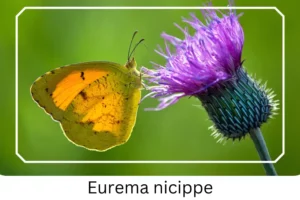Sleepy Orange (Eurema nicippe)
The Sleepy Orange butterfly, a spectacle of fluttering beauty, graces the landscapes of North America with its vibrant presence throughout the year. This species, known for its brilliant yellow-orange hues, embarks on a southward migration to warmer climates during winter, showcasing the remarkable adaptability and resilience of these creatures. Their pristine appearance and lively coloration make them a fascinating subject for enthusiasts and naturalists alike.
Scientific Classification
- Family: Pieridae
- Genus: Eurema
- Scientific Name: Eurema nicippe
Overview
Belonging to the diverse and colorful world of butterflies, the Sleepy Orange butterfly (Eurema nicippe) stands out for its ubiquity across North America, including the West Indies, Belize, and Costa Rica. These butterflies thrive in a variety of habitats, from the dampness of swamps to the openness of woodlands, embodying the rich biodiversity of their environments. Their life cycle, from the delicate egg to the striking adult, unfolds with a grace that mirrors the natural world’s intricate beauty.
Description and Identification
Caterpillar
The initial stage of the Sleepy Orange’s life cycle begins with the caterpillar, a small creature adorned with fine, light hairs and sporting a grayish-green hue. A distinctive whitish-yellow stripe runs along its sides, setting it apart from other larvae. These caterpillars are voracious feeders on the leaves of specific host plants, preparing for the next phase of their transformation.
Pupa
Transitioning into the pupal stage, the Sleepy Orange chrysalis exhibits an impressive range of colors, from vibrant green to dark brownish-black. This variability allows it to blend seamlessly with the surrounding foliage, a natural camouflage that protects it from predators as it undergoes metamorphosis.
Adult Butterfly
Sexual Dimorphism: Adult Sleepy Oranges are visually identical across genders, though males tend to be slightly brighter and smaller than their female counterparts.
Color and Appearance: Upon reaching adulthood, the Sleepy Orange butterfly reveals its true splendor. With wings unfurled, it displays a radiant orange color, bordered by a distinctive, uneven brown band that thickens towards the wingtips. A notable dark spot adorns the upper middle of each wing, adding to its charm. In contrast, the underside of the wings presents a muted beige to pale yellow shade, offering a stark difference from the dorsal vibrancy.

 Average Wingspan: The wingspan of these butterflies ranges from 1 3⁄8 to 2 1⁄4 inches (35–57 mm), a testament to their delicate yet expansive beauty.
Average Wingspan: The wingspan of these butterflies ranges from 1 3⁄8 to 2 1⁄4 inches (35–57 mm), a testament to their delicate yet expansive beauty.
Flight Pattern: Their flight is moderate, characterized by a graceful and deliberate movement that captivates onlookers.
Eggs
The reproductive cycle of the Sleepy Orange butterfly begins with the laying of pale greenish-yellow eggs, which darken to reddish tones just before hatching. These eggs are strategically placed on the undersides of leaves or flowers, ensuring safety and nourishment for the emerging caterpillars.
Quick Facts | |
| Distribution | Predominantly found in North America, extending to the West Indies, Belize, and Costa Rica. |
| Habitat | Adaptable to a variety of environments, including swamps, meadows, woodlands, and more. |
| Host Plants | Prefers Sicklepod senna (Cassia obtusifolia) and coffee senna (Cassia occidentalis). |
| Adult Diet | Primarily consumes flower nectar. |
How to Identify Sleepy Orange Butterfly?
Identifying a Sleepy Orange butterfly can be a delightful challenge for enthusiasts. Key characteristics include its vibrant yellow-orange wings with distinctive brown borders and a dark spot on the upper side, which are visible when the wings are spread. When the wings are closed, the underside reveals a more subdued beige to pale yellow color. Observing the flight pattern, which is moderate and purposeful, can also assist in identification. Furthermore, their presence in various habitats, from swamps to open woodlands, and their reliance on specific host plants for their larvae, such as the Sicklepod senna, are indicative markers of this species. Learning these traits allows observers to distinguish the Sleepy Orange from other butterflies with confidence.
Did You Know?
- The name “Sleepy Orange” is believed to be derived from the small dark spots on the upper wings, resembling closed or ‘sleeping’ eyes.
- Unlike many butterfly species that exhibit significant sexual dimorphism, male and female Sleepy Oranges are visually similar, with only subtle differences in brightness and size.
- The Sleepy Orange’s ability to change the color of its chrysalis for camouflage is a remarkable adaptation for survival.
Conclusion
The Sleepy Orange butterfly embodies the intricate beauty and adaptability of nature’s creations. From its early days as a caterpillar to its breathtaking transformation into an adult butterfly, each stage of its life cycle is a testament to the wonders of natural evolution. Observing these creatures in their natural habitats offers a glimpse into the delicate balance of ecosystems and the importance of preserving biodiversity for future generations.








